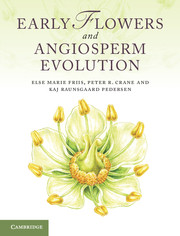Book contents
- Frontmatter
- Contents
- Preface
- 1 Introduction to angiosperms
- 2 The nature of the angiosperm fossil record
- 3 The environmental context of early angiosperm evolution
- 4 Stratigraphic framework and key areas for Cretaceous angiosperms
- 5 Angiosperms in context: extant and fossil seed plants
- 6 Origin and age of angiosperms
- 7 Phylogenetic framework and the assignment of fossils to extant groups
- 8 Fossils near the base of the angiosperm tree
- 9 Early fossil angiosperms of uncertain relationships
- 10 Early fossils of eumagnoliids
- 11 Fossils of monocots
- 12 Fossils of eudicots: early-diverging groups
- 13 Fossils of core eudicots: basal lineages
- 14 Fossils of core eudicots: rosids
- 15 Early fossils of eudicots: asterids
- 16 Patterns of structural diversification in angiosperm reproductive organs
- 17 History and evolution of pollination in angiosperms
- 18 History and evolution of dispersal in angiosperms
- 19 Vegetational context of early angiosperm diversification
- 20 The accumulation of angiosperm diversity
- References
- Index
11 - Fossils of monocots
Published online by Cambridge University Press: 07 September 2011
- Frontmatter
- Contents
- Preface
- 1 Introduction to angiosperms
- 2 The nature of the angiosperm fossil record
- 3 The environmental context of early angiosperm evolution
- 4 Stratigraphic framework and key areas for Cretaceous angiosperms
- 5 Angiosperms in context: extant and fossil seed plants
- 6 Origin and age of angiosperms
- 7 Phylogenetic framework and the assignment of fossils to extant groups
- 8 Fossils near the base of the angiosperm tree
- 9 Early fossil angiosperms of uncertain relationships
- 10 Early fossils of eumagnoliids
- 11 Fossils of monocots
- 12 Fossils of eudicots: early-diverging groups
- 13 Fossils of core eudicots: basal lineages
- 14 Fossils of core eudicots: rosids
- 15 Early fossils of eudicots: asterids
- 16 Patterns of structural diversification in angiosperm reproductive organs
- 17 History and evolution of pollination in angiosperms
- 18 History and evolution of dispersal in angiosperms
- 19 Vegetational context of early angiosperm diversification
- 20 The accumulation of angiosperm diversity
- References
- Index
Summary
Monocots (monocotyledons) are a major clade of angiosperms that have been recognised as a natural group since John Ray in the early eighteenth century (Ray, 1703). The name refers to the single cotyledon, a feature found in all members of the group. Monocots also lack the ability to produce secondary xylem and phloem in the same way as other angiosperms and most other seed plants. Nevertheless, they are hugely diverse in habit and form. Monocots include aquatic herbs and tall palms as well as Arctic grasses and tropical epiphytes. Taken together, monocots account for a little over a fifth of angiosperm species. A recent attempt to develop a global checklist of all monocots at the species level suggests that about 70 000 extant species of monocot are currently known (The Board of Trustees of the Royal Botanic Gardens, 2008). In this chapter we provide a brief overview of monocot classification and consider the fossil history of the group, focusing particularly on the earliest records and other evidence of monocots from the Cretaceous.
Classification of monocots
Rapid progress in the development of a phylogenetic classification of monocots over the past 25 years was stimulated in large part by the important synthetic work of Dahlgren et al. (1985). This was taken forward in a series of symposia (Rudall et al., 1995; Wilson and Morrison, 2000; Columbus et al., 2006) as well many individual research contributions. Sampling for phylogenetic analyses based on molecular data has been especially intensive and a broad consensus has emerged on the major clades of monocots (Figure 11.1), as well as many aspects of phylogenetic pattern within these groups (e.g. Chase, 2004). There is also agreement on some aspects of the relationships among these clades.
Information
- Type
- Chapter
- Information
- Early Flowers and Angiosperm Evolution , pp. 249 - 274Publisher: Cambridge University PressPrint publication year: 2011
Accessibility standard: Unknown
Why this information is here
This section outlines the accessibility features of this content - including support for screen readers, full keyboard navigation and high-contrast display options. This may not be relevant for you.Accessibility Information
- 1
- Cited by
